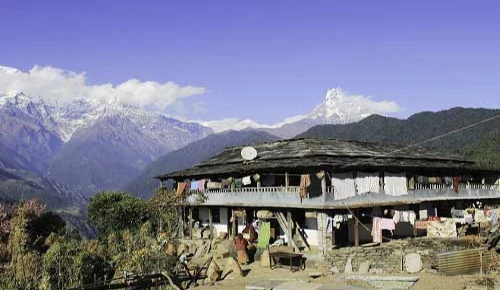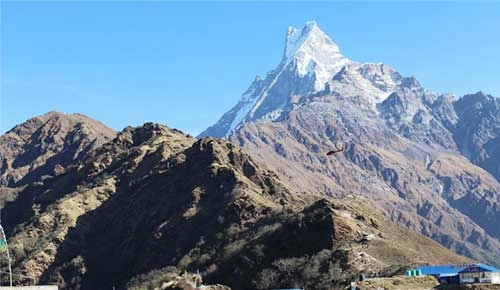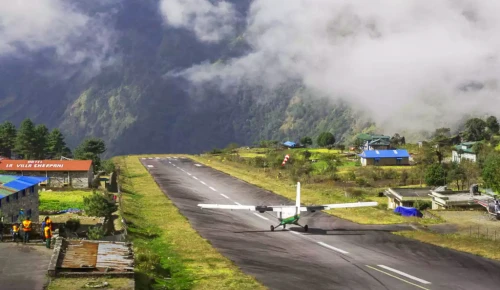Top 5 Medicinal Plants in the Manaslu Region
Nepal is an attractive destination due to breathtaking landscapes, rich culture, and trekking expeditions. Treks offer the best dramatic mountain scenery and well-established trails, especially in the Everest and Annapurna regions. The allure of Manaslu lies in those who wish to avoid the crowd and tread on quiet paths.
The Manaslu Circuit, which encircles Manaslu (the world's eighth highest peak), is a spectacular trek. The route traverses through a variety of landscapes, including terraced agriculture, subtropical woodlands, alpine meadows, and high passes. The hike will take you through distant Tibetan-influenced settlements as well as breathtaking natural vistas, making it both culturally and visually memorable.

Apart from the scenic beauty, the Manaslu region boasts an exhaustive variety of medicinal plants used in the traditional Himalayan system of medicine. As you traverse through different elevation zones, you might encounter herbs like Yarsagumba, Kutki, Sugandhawal, Chiraito, and Himalayan Rhubarb. Each of these plants grows in a particular altitude and terrain, thereby putting forth a rare opportunity for trekkers to spot them in nature.
In this blog, we outline the top five medicinal plants of the Manaslu Circuit and provide tips on responsible spotting during the trek itself.
Table of Contents
Top 5 Medicinal Plants Along the Manaslu Trek
There is a possibility you will encounter these medicinal plants during your Manaslu Circuit trek. These plants offer very high medicinal value and great benefits for both the locals and the country’s economy.
Nirmasi/Chiraito (Swertia chiraita)

- Species: Swertia chirayita (syn. Swertia chirata), family Gentianaceae
- Common names: Chirayita, Chirata, Nirmasi, Bitter stick, East Indian gentian
- Habitat & elevation: Grows 1–3 m tall on north-facing slopes, mountain pastures, and damp woodlands at 1 500–3 000 m along the Manaslu Trek (Philim, Namrung, Samagaon)
- Flower and stem: Opposite lance-shaped leaves; clusters of greenish-yellow to purplish-tinged flowers; four-angled orange-brown stem
Traditional Medicinal Values of Nirmasi/Chiraito:
- These are some of the primary health advantages that Nirmasi and Chiraito provide.
- Fever & Malaria: Key bitter tonic in Ayurveda, Unani & Siddha for reducing fever and combating malaria
- Liver & Digestive Aid: Used to treat liver disorders, jaundice, indigestion, dyspepsia, and loss of appetite.
- Diabetes management: Shown to lower blood sugar, enhance insulin sensitivity, used in antidiabetic traditional remedies
- Anti-inflammatory & Antimicrobial: Effective against inflammation, skin diseases, and microbial infections
- Other benefits: Includes antipyretic, hepatoprotective, anthelmintic, antioxidant, analgesic, blood-purifying, and skin-healing properties
Conservation & Sustainability
- Endangered status: Overharvesting and habitat loss have driven populations to near-endangered status.
- Biotechnological efforts: Micropropagation and tissue-culture initiatives support sustainable cultivation and genetic conservation.
Padamchal/Himalayan Rhubarb (Rheum australe)

- Species: Rheum australe (syn. Rheum emodi), family Polygonaceae—commonly called Himalayan rhubarb, Indian rhubarb, Padamchal, or red-veined pie plant
- Habitat & altitude: Thrives in sub-alpine and alpine zones at 3 000–4 800 m, on grassy slopes, rocky crevices, moraines, and near streams along the Manaslu Circuit (notably Lho, Sho, and Samagaon).
Traditional Medicinal Uses
- Digestive health: Used as a laxative for constipation, diarrhea, indigestion, gallbladder complaints, and hemorrhoids.
- Wound healing & skin care: Applied externally for burns, cuts, and skin eruptions; also alleviates muscular pain, cough, and cold.
- Multi-system remedy: In Ayurveda, Unani, and Tibetan medicine, it treats maladies of the circulatory, endocrine, respiratory, and skeletal systems, as well as infectious diseases.
- Reproductive health: Regulates menstrual issues, relieves cramps; not recommended during pregnancy or lactation.
Conservation & Sustainability
- Endangered status: Overharvest and pharmaceutical demand have placed it on endangered species lists
- Conservation efforts: Tissue-culture propagation, sustainable harvesting programs, and community forestry approaches are underway to prevent depletion.
Yarshagumba (Cordyceps sinensis)

- Species: Ophiocordyceps sinensis (syn. Cordyceps sinensis), part of the entomopathogenic fungus family Ophiocordycipitaceae. Known locally in Tibetan as "Yartsa gunbu"—literally "summer grass, winter worm"—and in Nepali as Yarsagumba
- Altitude & location: Found in alpine meadows at 3,500–5,000 m across Nepal (Dolpa, Manang, Gorkha, Mugu), especially above Samagaon and Samdo on the Manaslu Circuit
Traditional Medicinal Uses
- Boosts energy & stamina: Known as “Himalayan Viagra,” it enhances endurance, oxygen uptake, and athletic performance
- Aphrodisiac & reproductive tonic: Widely used to increase libido, sexual function, and hormone precursors.
- Supports kidney, liver & respiratory health: Helps manage chronic coughs, asthma, fatigue, liver protection, and kidney disorders
- Boosts immunity & anti-aging: Rich in polysaccharides, cordycepin, antioxidants; supports immune function, memory, and longevity
Conservation & Socioeconomic Impact
- Endangered & overexploited: Classified as vulnerable (IUCN); habitat loss, unsustainable harvesting, and illegal trade threaten populations.
- Economic lifeline & societal cost: Provides 40–50% of annual income for rural households, yet has fueled conflicts—murders over harvest turf, the spine of the Maoist-era economy.
Kutki (Picrorhiza kurrooa)

- Species: Picrorhiza kurrooa (syn. Picrorhiza scrophulariiflora), family Plantaginaceae. Locally known as Kutki and closely related to Picrorhiza kurroa, though non-threatened under CITES
- Elevation & Location: Grows in alpine and subalpine zones at 3 500–4 800 m. You'll find it across the Manaslu Circuit: Samagaon, Larke Pass, and alpine meadows near Samdo
Traditional & Medicinal Uses
- Liver & Digestive Aid: A bitter tonic that promotes bile flow, supports digestion, and helps manage jaundice, gastric ulcers, and hepatoprotection
- Fever & Cold Remedy: Employed as an antiperiodic for recurring fevers, including malaria, and to ease throat and respiratory symptoms
- Anti-inflammatory & Immunomodulatory: Contains kutkin, picroside I & II, and apocynin—granting liver protection, antioxidant, and anti-inflammatory effects
- Antidiabetic Activity: Lab studies on rats indicate its ethanol extract significantly lowers blood glucose levels—promising for type 2 diabetes
Sugandhawal/Spikenard (Nardostachys jatamansi)

- Species: Nardostachys jatamansi (syn. N. grandiflora), family Valerianaceae; locally called Jatamansi or Sugandhawal, also known as Himalayan spikenard
- Altitude & Range: Grows in sub-alpine to alpine zones at 3 600–4 500 m along rocky slopes and meadows above Samagaon and Larke Pass on the Manaslu Circuit.
Traditional Medicinal Uses
- Aromatic & Sacred: Since Vedic times, used as incense and in religious rituals
- Nervine & Sedative: Calms the mind, aids insomnia, anxiety, and hysteria; supports memory and nervous system health.
- Respiratory & Digestive: Treats coughs, asthma, flatulence, indigestion, and hiccups.
- Cardiotonic & Diuretic: Balances heart palpitations and hypertension; supports kidney function and regulates menstruation
- Skin & Wound Care: Used for wounds, eczema, and as antiseptic poultice
- Spiritual Tradition: Called yoga herb—used in meditation for grounding, incense for sanctifying spaces
Conservation & Sustainability
- Threat Status: Critically endangered by IUCN, CITES Appendix II due to overharvesting.
- Sustainability Efforts: Push for regulated collection, wild population protection, and promotion of organic cultivation.
How to Identify Medicinal Plants on the Manaslu Circuit Trek?
Hikers who are paying close attention can see many useful Himalayan medicinal plants while trekking the Manaslu. Each species, from the valuable Yarsagumba to the fragrant Sugandhawal, grows in different elevation zones and times of the year. Trekkers can find these natural gems in a respectful and responsible way if they know the altitude, how the plants look and smell, and the terrain.
- Understand Altitude Ranges: Different medicinal plants grow at specific elevations. Yarsagumba appears above 3,500 m, Kutki, Sugandhawal, and Himalayan Rhubarb between 3,000–4,800 m, and Chiraito in mid-hills around 1,500–3,000 m.
- Go During the Right Season: Timing matters for spotting these plants. Yarsagumba is best seen in May–June, Kutki and Sugandhawal bloom during July–August, and Rhubarb and Chiraito are common from May to September.
- Focus on Specific Terrains: These herbs prefer sunny, well-drained spots such as alpine meadows, grassy slopes, rocky hillsides, and glacial moraine fields.
- Learn Their Unique Shapes: Each plant has a distinct look—Yarsagumba grows from caterpillar remains, Kutki has purple spikes, Sugandhawal bears bell-shaped flowers, Chiraito is tall with yellowish flowers, and Rhubarb has big red stalks with heart-shaped leaves.
- Use Leaf Size and Shape as Clues: Kutki has spoon-like leaves (3–6 cm), Chiraito features lance-shaped leaves growing opposite each other, and Himalayan Rhubarb shows off large leaves up to 60 cm wide.
- Notice Flower Colors and Structures: Sugandhawal has pink-white bell flowers, Kutki displays purple-violet spikes, Chiraito grows purplish clusters, and Rhubarb blooms red-purple.
- Trust Your Nose: Sugandhawal emits a sweet, musky fragrance, while Kutki and Chiraito have a bitter, earthy smell when crushed—use scent to confirm identity.
- Ask Local Experts for Guidance: In villages like Samagaon, Samdo, Philim, and Namrung, locals and guides often know the best areas to find these plants—many grow near trekking trails.
- Spot Companion Plants Nearby: Medicinal plants often share habitat with species like edelweiss, blue poppy, gentiana, anemone, and rhododendron—seeing these may signal you’re close.
- Respect Conservation Rules: Harvesting plants like Yarsagumba, Kutki, and Chiraito requires permits under MCAP/community rules. Always practice sustainable, observation-only trekking to help preserve these rare species.
10 Amazing Facts About Medicinal Plants
These are some facts about these medicinal plants that you definitely didn’t know:
- Yarsagumba is a parasitic fusion of a fungus and a caterpillar, often referred to as “Himalayan Viagra” for its aphrodisiac and energy-boosting effects.
- Chiraito contains the bitter compound amarogentin, one of the most bitter substances known in nature, used traditionally to treat fevers and digestive disorders.
- Kutki is a hepatoprotective herb known to regenerate liver tissue and is often used in Ayurvedic treatment for jaundice and hepatitis.
- Spikenard (Sugandhawal) produces a fragrant essential oil used in ancient Egyptian and Roman perfumes and sacred rituals in Hindu and Buddhist traditions.
- Himalayan rhubarb is a natural dye source—the root produces a yellow to red pigment used in traditional fabric coloring and paper-making.
- Yarsagumba can fetch prices higher than gold in international markets due to its rarity and medicinal value.
- Kutki thrives only in narrow altitude ranges between 3,000 and 4,500 m, making its cultivation and conservation a significant challenge.
- Chiraito has strong antioxidant properties, with research showing it helps in managing diabetes and oxidative stress-related conditions.
- Spikenard is listed as “critically endangered” due to overharvesting and habitat loss, despite its high demand in herbal and cosmetic industries.
- Himalayan rhubarb contains anthraquinones like emodin, which have shown anti-cancer and anti-inflammatory properties in laboratory studies.
Which Routes To Take for Medicinal Plant Watching?
While you are on the Manaslu Trek, you will find the following locations best for finding the plants:
- Machha Khola to Jagat (900m–1,300m): Tropical climate ferns, bamboo, and shrubs.
- Philim to Deng (1,600 m–1,800 m): Dense forest, which is home to many species of orchids, lichens, and mosses.
- Namrung to Lho (2,400m–3,200m): Rhododendrons, primroses, and blue poppies begin to show.
- Samagaon and Samdo (3,500 m–4,000 m): In the Alpine zone, which includes edelweiss, gentians, and yarsagumba.
- Larke La Pass (5,106 m): High in the mountains, also at the tundra level, you’ll find mosses, lichens, and low-growing cushion plants.
Top Manaslu Trekking Packages by Nepal Trek Adventures for All Levels and Durations
Explore a range of Manaslu trekking packages offered by Nepal Trek Adventures (NTA), tailored for different interests, fitness levels, and travel durations. These are some of the trekking packages that NTA has to offer for your next Manaslu trek. based on your taste:
- Manaslu Circuit Trek - 13 Days
- Manaslu Express Trekking - 10 Days
- Manaslu Tsum Valley Trekking
- Manaslu Circuit Luxury Trek
- Manaslu Base Camp Trekking
Conclusion
The Manaslu region isn't jus for trek—it's a journey through untouched Himalayan beauty, rich culture, and rare medicinal biodiversity. From the mysterious Yarsagumba to the healing Chiraito, each step introduces you to natural wonders found nowhere else on Earth. Whether you're a nature lover, a curious explorer, or a wellness enthusiast, this trail offers something truly unforgettable.
Ready to discover the hidden treasures of Manaslu? Book your Manaslu trek with Nepal Trek Adventures today and experience the magic firsthand!








